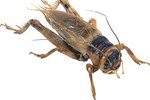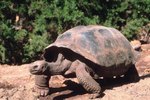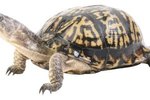
Three areas of the world contain rainforests: Central and South America; central and western Africa; and southeast Asia. Each of these areas is home to dozens of turtles living on land and in water. Though most of these species are opportunistic omnivores, differences in diet are noted between species, and some species have evolved into prey specialists.
Rainforest Tortoises
The rainforest is home to many species of tortoise, including two popularly kept as pets: red-footed tortoises (Chelonoidis carbonaria) and yellow-footed tortoises (Chelonoidis denticulata). These colorfully footed turtles are omnivores that eat plant material, invertebrates like snails and carrion found on the forest floor. Fruit is an important dietary component of their diet, and the breeding behavior of male yellow-footed tortoises is known to be affected by fruit abundance.
Semi-Aquatic and Terrestrial Rainforest Turtles
Semi-aquatic and terrestrial rainforest turtles are generally omnivores since rainforest habitats offer a lot of fungi, fruit and invertebrates for food. In contrast to the tortoises of the rainforest, which rely heavily on plant material, some rainforest turtles, like Home’s hinge-back turtle (Kinixys homeana), are noted for being among the most highly carnivorous terrestrial turtles known to science. The tiny Vietnamese leaf turtle (Geoemyda spengleri) is also an omnivore that is especially fond of earthworms and slugs, though they likely eat fallen fruit as well.
Aquatic Rainforest Turtles
Turtles of the rainforest waterways eat a diet similar to aquatic turtles in other regions. Most species, like the Vietnamese pond turtle (Annamemys annamensis), eat an omnivorous diet, including crabs, crayfish, fish and aquatic vegetation. Fly River turtles (Carettochelys insculpta ) of New Guinea and Australia inhabit crystal clear waters and consume fish, invertebrates and plant material.
Dietary Specialists of the Rainforest
Some turtles found in the rainforest are dietary specialists. The fully aquatic mata mata (Chelus fimbriata) has a number of unique adaptations that facilitate the capture of fish. Remaining completely still in the muddy waters of the South American rainforest pools, these turtles are covered in small flaps of skin that make the turtle look like an algae-coated rock in the pool. Through a highly developed suction feeding mechanism in the mouth, the turtles quickly suck in entire fish when they venture too close. The giant Amazon River turtle (Podocnemis expansa) is another dietary specialist that attains its large size on a diet of fallen fruit and seeds.
References
- Tortoise Trust: Tropical Rainforest Tortoises and Turtles: Practical Techniques for the Provision of Adequate Ambient Humidity in Captivity
- Arkive.org: South American Yellow Footed Tortoise (Chelonidus Denticulata)
- Woodland Park Zoo: Red-Footed Tortoise
- Arkive.org: Home's Hinge-Back Tortoise (Kinixys homeana)
- The Turtle Pond: The Vietnamese Leaf Turtle, Geoemyda spengleri
- National Aquarium: Giant Amazon River Turtle
- The Asian Turtle Consortium: Species Accounts: Annamemys Annamensis: Vietnamese Pond Turtles
- University of North Carolina: Mata Mata Turtle
- Austin's Turtle Page: Fly River Turtle Caresheet
Photo Credits
-
PhotoObjects.net/PhotoObjects.net/Getty Images



